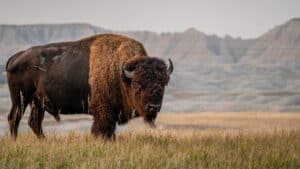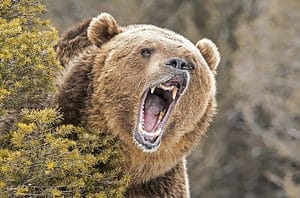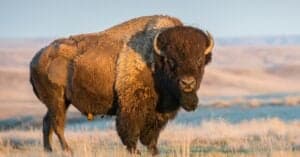Bison is a uniquely large species of bovines from the Bison genus and a vast cattle tribe, Bovini. This tribe includes antelopes like saola, African and Asiatic Buffalo, and a clade with the bison and the wild cattle of the genus Bos. These animals have many extinct species because they have largely lost their natural habitats. However, of all the extinct species of bison, there are still two surviving species: the European bison and the American bison. This article will discuss a few things you need to know about the American Bison, as well as the largest bison herd in America – found in Yellowstone National Park.
How to Identify the American Bison
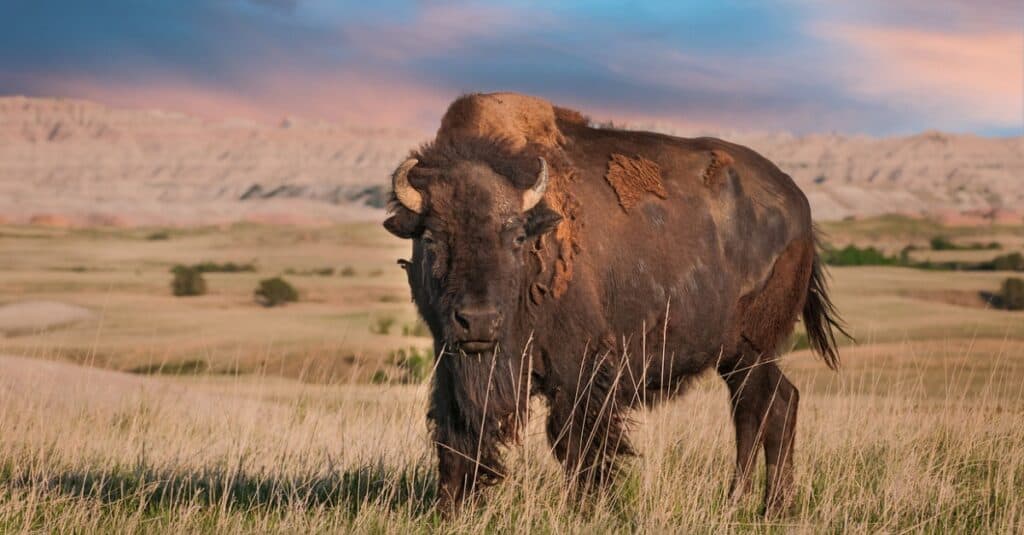
The American bison has a large build and short legs.
©Geoffrey Kuchera/Shutterstock.com
Bison sometimes referred to as buffaloes, are North America’s largest terrestrial animals. These mammals are muscular and broad with characteristic cloven hooves and skins with long rough coats of hair. However, they look like buffalo and are sometimes called that – even though they are not buffaloes. They are only distantly related to the true buffaloes as they share the same tribe. The American bison has 15 ribs and four lumbar vertebrae. They have a large build and short legs, and because of how often they graze, their heads hang low.
The adult American bison grows to an average height of 6ft 7 inches (2 meters) and 11 ft 6 inches (3.5 meters) in length. They weigh between 400 -1,270 kilograms (800-2800 pounds), making them the largest land-dwelling mammals in North America. Also, note that these animals are nomadic grazers and move in herds, so it is unlikely that you will find a bison alone. Though considered large, wild, and dangerous, bison have notably complex relationships with humans as they have been successfully domesticated. Now they serve as working animals and are bred for beef, dairy products, and leather.
The Largest Bison Herd in America

The American bison is the largest land mammal in North America!
©iStock.com/IngerEriksen
The bison herd in Yellowstone National Park is the largest in America, with a population of about 5,000 to 6,000 bison. There is usually an increase of bison during the breeding time of these animals, and regardless of what season it is, there has never been less than 5000 bison in the Yellowstone bison herd.
If you want a good view of bison in their natural habitat, the Yellowstone bison herd is one of your best choices. You would see so many here gathered at different points feeding on the grassland. More so, you are most likely to see them in herds of hundreds rather than alone, which gives you a more remarkable and enjoyable view.
The History of the Yellowstone Bison Herd
America’s largest bison herd is located at Yellowstone National park, Wyoming, founded in 1972. It is considered the oldest and the most significant public bison herd in the United States. Yellowstone National Park mainly features the Plains bison subspecies of the American bison. Yellowstone National Park is the only location where bison never went extinct, as it has always been their natural habitat. It is also the only place where bison have lived continuously since prehistoric times. Unlike most parks, Yellowstone bison herds are allowed to roam freely.
In Yellowstone National Park, bison are allowed to exhibit all their natural traits, just like their ancestors in the wild. They compete for mates, then migrate to new areas within the park and live freely. Because of how they live naturally in this habitat, bison populations have been successfully reintroduced despite that they were on the brink of extinction. However, these animals are prone to brucellosis, a livestock disease transmitted to wild bison, elk, and cattle through infected fetal tissue. Because of the disease risk, as well as migration issues, wild bison conservation is one of Yellowstone’s most complex resource issues.
When are Bison Most Active in the Yellowstone National Park?
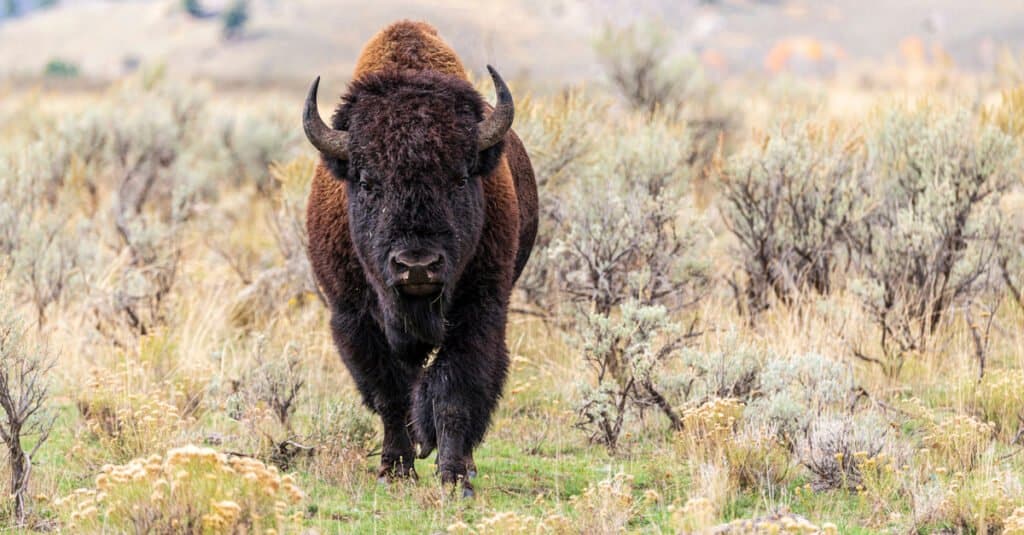
Although bison are more active during the day and dusk, you might still notice a little activity at night.
©Grey Mountain Photo/Shutterstock.com
Bison are giant mammals, and learning when they are active or how active they get is essential for you, especially if you’d be going into Yellowstone National park for sightseeing. Bison are more active during the day and dusk; though, you might still notice a little activity at night. However, be aware that when you are at Yellowstone National Park, ensure to stay at least a hundred yards away from them; they are as big as they are swift, and they can be risky to be around.
Bison are highly active animals; they mostly roam and graze – which is why they are considered nomadic grazers. These strong mammals feed for about 8- 12 hours daily. They are also active during their breeding season between July and August, and females give birth to their young calves in the spring. So you would also see a good number of these animals roaming the park this season, especially the little calves.
What Part of the Yellowstone National Park are Bison Herds More Populated?
Bison change their location at different times of the year. In the summer months, you can view these animals more easily because they are spread around the grassland area in herds grazing. That means you would get the best views of bison in the warmer months. The Hayden and Lamar valleys are where you’ll find the most population of bison in the picturesque Yellowstone park. Bison always take refuge in this valley no matter the season, so much so that they are found here throughout the year.
In the summertime, these animals move in herds of almost 200 bison but reduce to nearly 10 to 20 bison per herd during the winter. When it’s colder, they roam around the park in smaller herds, trying to find the best spot. Rarely do bison migrate out of the park, as this has become their longtime sanctuary.
Bison Conservation Efforts are a Great Success
Bison thrived in North America during prehistoric times and beyond with millions roaming a wide range from Alaska to Mexico to the eastern Appalachian Mountains. The history of bison and Native Americans are intertwined – with the animal providing them with food, clothing, fuel, tools, shelter, and spiritual value before the European invasion.
European settlers pushing west, and later on – employees of expanding railroads, reduced the millions of bison to only a few hundred by the late 1800s. In 1883, future President Teddy Roosevelt traveled to Dakota Territory to hunt bison. After spending a few years in the west, he returned to New York with a new outlook on life and paved the way for the conservation movement.
In 1905, along with William Hornaday, he formed the American Bison Society to save the almost extinct animal. By 1913, the program, housed at what today is the Bronx Zoo, had enough bison to restore a free-ranging herd. They donated the 14 bison to Wind Cave National Park in South Dakota. Those 14 bison have helped establish other herds, including the great herd of Yellowstone.
Today, bison live in all 50 states, including tribal lands, wildlife refuges, national parks, and private lands, and are being re-established in Mexico.
The photo featured at the top of this post is © O.S. Fisher/Shutterstock.com
Thank you for reading! Have some feedback for us? Contact the AZ Animals editorial team.




